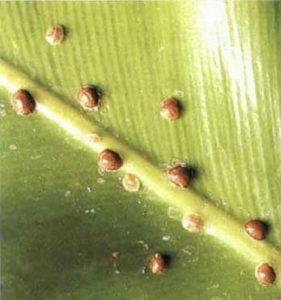False shield: photo of the pest and methods of dealing with it
Planet Earth is inhabited by a huge number of living organisms. There are familiar, and there are not familiar to mankind. And there are those who can easily be confused with the well-known. These true lovers of disguise are masterfully able to confuse even knowledgeable minds. These are false shields, which will be discussed in this article.
Content
False shield: photo
Description of the pest
Name: False shields or coccids
Latin:coccidaeClass: Insects - Insecta
Squad: Hemiptera - Hemiptera
 | Habitats: | garden, kitchen garden, greenhouses, rooms |
 | Dangerous for: | citrus, ferns, conifers |
 | Means of destruction: | mechanical cleaning, folk methods |
The false shield insect has the appearance of an oval-shaped flattened formation. Initially, these formations have a milky color, then change it to dark brown. Under such shields, parasite larvae live until they hatch.
These formations are often not taken seriously, because often people do not pay attention to the first appearance. They are more like growths that can be confused with a manifestation of a disease, rather than a pest.
Difference from shield
It is not for nothing that the false shield got its name, because it is so easy to confuse it with the shield. However, there are some distinctive nuances.
- The false shield does not separate from its shield, it can only be removed completely. It looks like a growth, convex.
- Shield separates from the shield when trying to "remove" it, because it serves as a barrier. It is flatter and thinner.
What feeds on
Like any living creature, the false shield needs to eat. They eat different types of plants:
- citrus;
- ferns;
- crassian;
- cycads;
- psidums;
- myrtle.
Types
In nature, there are about a thousand species of pests. Here is a list of the most famous.
Signs of infection
The first signs of damage are quite difficult to identify, especially in small quantities.
- Having stuck to the plant, the parasites begin to actively drink its juices. For this reason, the leaves of plants become lifeless, lose their luster, acquire a brown color.
- Whitish sticky secretions and dark spots can be found on the leaves, which lead to the death of parts of the plant.
- With a strong infection, round brown growths are already visible.
Preventive measures
Better to prevent than deal with the consequences. This expression is true in the case of defeat by a false shield. There are two simple ways to prevent the occurrence.
Pest control
If you do not fight the pest, then the plant has every chance of dying. There are several ways to deal with insects.
First of all, if possible, you need to isolate the plant from healthy ones.
Mechanical cleaning
For some plants, procedures can be fraught with injuries, but otherwise there is no way to remove the false shield.
- Isolate the diseased plant, wipe the affected area with a cotton swab with alcohol. Be sure to wipe it off, even if you have to wipe it with a scraper. Inspect and process the trunk, the most protected places.
- Replace the top layer of soil, it may contain eggs and larvae.
- Wash in the shower several times.
- Treat the entire plant with concentrated soapy water and leave to dry.
Folk remedies
Oils are effective folk methods. They completely process the flower, which creates a film and the insect cannot eat. Such means are:
- machine oil;
- olive;
- kerosene.
Chemicals
Insecticides help with mass infestation when nothing else will help. You can use Aktara or Fitoverm.
The dosage for indoor plants is indicated in the instructions for preparations.
Conclusion
Sometimes amazing things happen in nature and animals disguise themselves as one another. Even being sure that the plant is affected by a specific type of pest, it is worth taking a closer look, maybe another masker is playing a joke with the human eye. This is what happens with the shield and the false shield.
Previous
